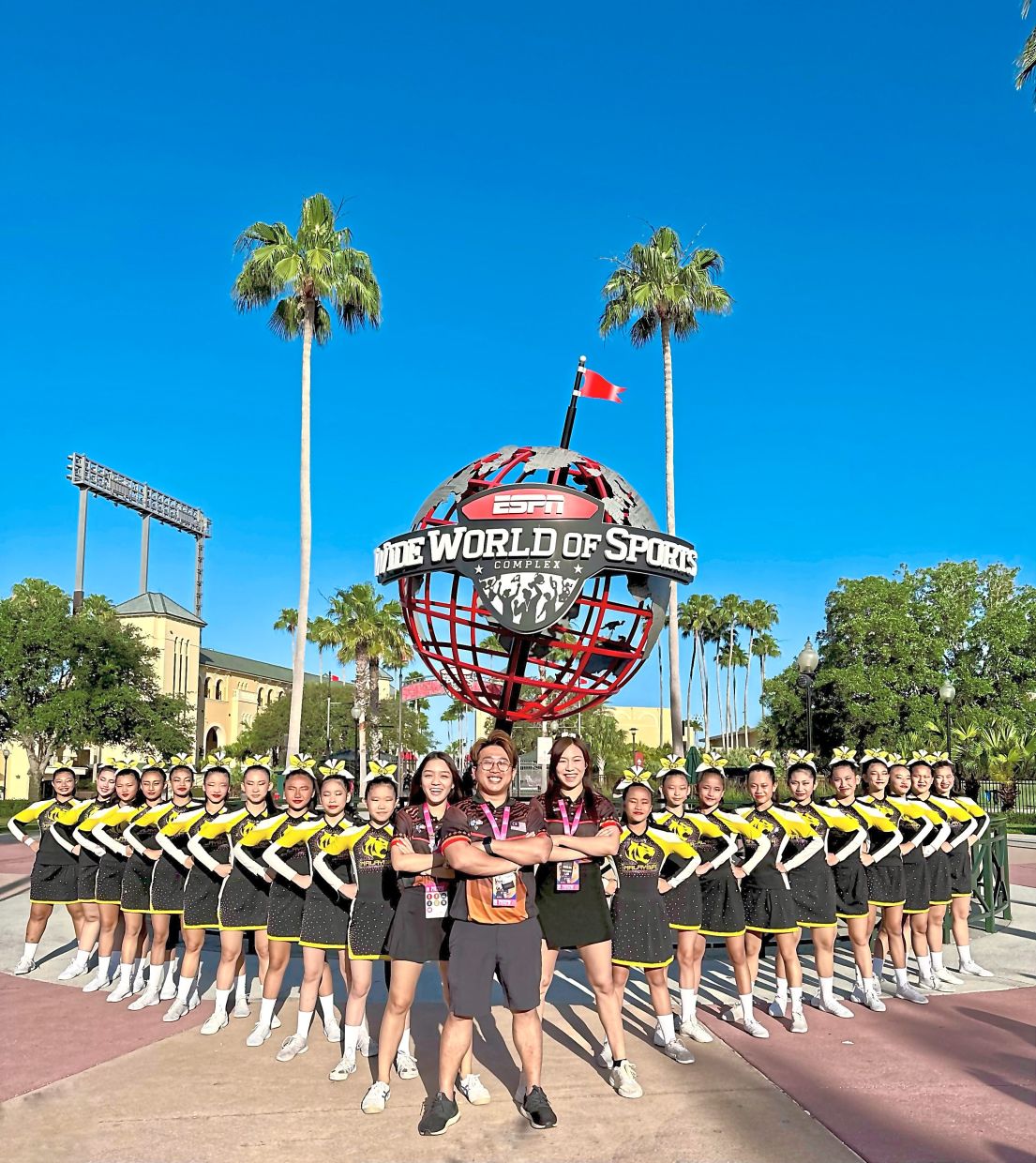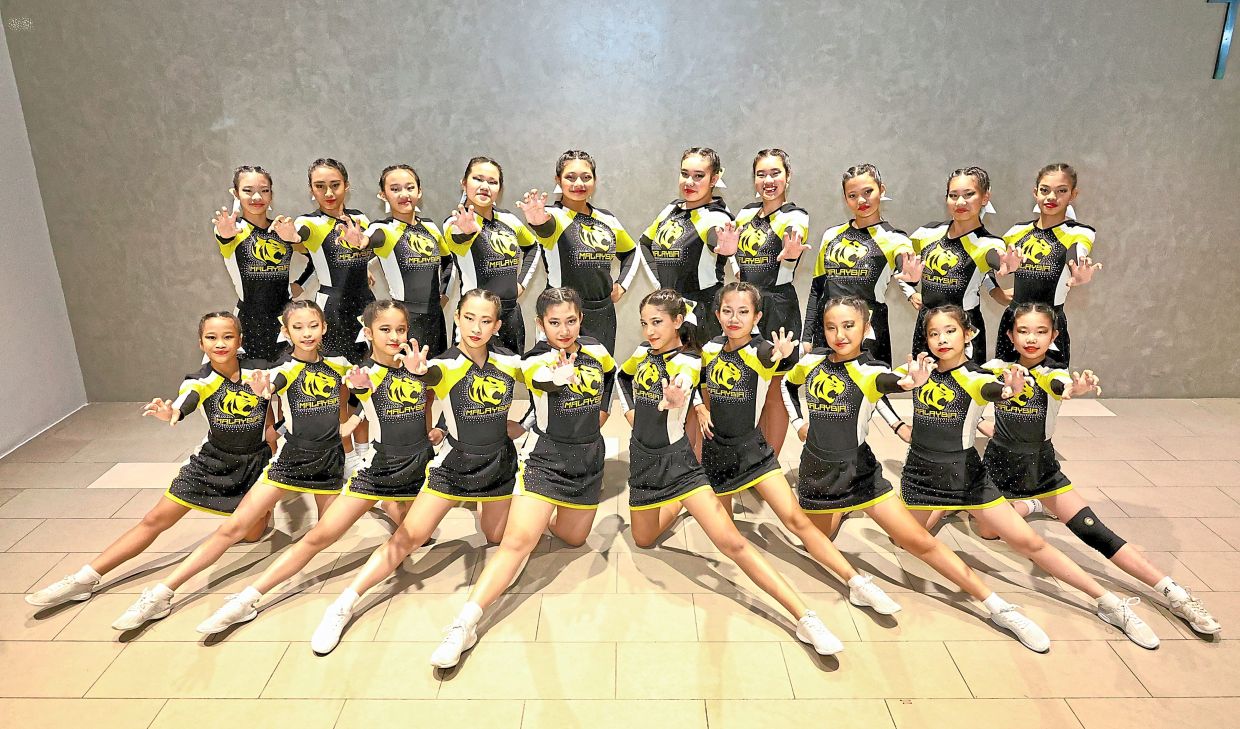Team Malaysia Youth All Girls (TMYAG), Malaysia's national cheerleading team youth division, in Orlando, the United States. Photo: Team Malaysia Cheer
When 20 teenage girls from Malaysia’s national youth cheerleading team travelled to Orlando, Florida, in the United States, to compete in two international competitions, little did they realise they would return as the champions.
Team Malaysia Cheerleading Youth All Girls (TMYAG) bagged the gold medal in the International Cheerleading Cup 2024 which took place on April 28 and 29, beating other finalists Mexico (second place) and Ecuador (third place).
“Winning the International Cheer Cup is a pleasant surprise and getting the first place is so unexpected. It was great team effort by the girls and the coaches, Coach Wah Zhai and Coach Bayle,” says TMYAG manager Becky Gan.
“I believe that the team, standing on this podium at the ESPN Wide World of Sports Complex in Orlando, the US, representing Malaysia, will make a significant impact on our nation as a whole in the sport of cheerleading. And singing our national anthem in this stadium in the US was a dream come true, the feeling was indescribable,” says Gan.
TMYAG also won the bronze in the ICU World Cheerleading Championship 2024 which took place from April 24 to 26. In first and second place were Canada and Mexico, respectively.
For the young cheerleaders, to do so well in the international meet was thrilling.
“Our team is thrilled to get the gold in the International Cheerleading Cup 2024 and the bronze in the ICU World Cheerleading Championship 2024. We’re really proud to represent Malaysia and thankful for the opportunity,” says TMYAG co-captain Eva Marissa Ahmad Ridzuan, 14, in an interview from the US.
“We’re really glad to be here in the US. Winning the gold is a very special moment for us as a team,” adds co-captain Lee E Nin, 15.
“We’re so happy and excited that our team won. Winning means a lot to us because it’s a reward for all our hard work. Truly, Malaysia boleh!” says cheerleader Chew Xiao Wei, 12.
Gan adds that she is “super proud of the girls persevering despite all the challenges of jetlag, illness, and last minute changes in the routine”.
“A few of the girls became ill with viral fever on the day we landed in the US, but decided to persevere and proceed with all the days of training and competition. We were all also suffering from jet lag for many days,” she says.
“And, when we found out on Day One of the World Cheerleading Championship that two of our stunt execution techniques were at a risk of infraction, the coaches decided to change the skills (stunts) and choreography for Day Two. The team had to train right after the first day of competition and the next morning to adapt to the new changes to make sure the routine was performed well,” she adds.
Both competitions – the ICU World Cheerleading Championship and International Cheerleading Cup – were organised by the International Cheer Union.
Watch their performance in the semi-finals below:
Gan says they are really grateful to their supporters in Malaysia.
“Our friends stayed up to watch our routines which were aired live at Malaysian time 2.30am and 3.30am on April 25 and 26, and 10pm on April 29, and immediately messaged to congratulate us when we won, which was so amazing,” she says, adding that they "wished to thank Youth and Sports Minister Hannah Yeoh and both the Youth and Sports Ministry and Education Ministry, their corporate sponsors, schools, and biggest supporters: the parents”.
TMYAG head coach Choong Chen Wah and assistant coach Bayle Yong say they’re “really proud of the girls and thankful for everything that has happened for them this year”.
“We went with the expectation of just performing our best routine and letting the judges do the rest. The last performance turned out to be their best performance out of all their routines. The placing was a wonderful surprise for us and no words can express our feelings. We’re truly grateful for everyone that has supported us. This journey has been tough but it was all worth it,” they concur.
Teamwork matters
Co-captain Lee, who started cheerleading at seven, says that while cheerleading is fun, it can be really hard to master.
“A cheerleader needs to be physically and mentally strong, and well-prepared.
And, teamwork is very important because if just one person gives up during the routine, the whole thing will collapse. It takes the whole team to have a good routine.
Discipline and commitment are also important, she stresses.
“We have training sessions four times a week, and if just one cheerleader doesn’t show up, it impacts the performance of the whole team.
“There’s a very fast progression and everyone needs to be at the same level and keep up to progress together, and not get left behind,” she says.
“And, you need to trust your teammates because, for example, if you’re a flyer, and you don’t trust your bases, you won’t have the confidence to do all those stunts,” she adds.
Co-captain Eva Marissa, too, first got into cheerleading at seven, when she was in Standard One.
“It looked fun and although I don’t have any background in gymnastics or dance, I decided to try and learnt everything from scratch. It was very exciting!
“My mum has also always encouraged me to be adventurous and try new stuff,” she says, adding that cheerleading has enabled her to “make many good friends”.
According to manager Gan, cheerleading is a competitive sport that involves components such as jumps, dance, stunt sequences, pyramid sequences, standing tumbling, and running tumbling.
“It involves a great deal of discipline, teamwork, and working together with your teammates,” explains Gan who has been involved in cheerleading for over 10 years.
“As a cheerleader, you need to be mentally strong. And a team spirit is mandatory because if even one person in the team is having a bad day and not giving their 100%, it will affect the rest of the team, and ultimately, the team’s performance,” she adds.
Inclusivity is important
Assistant coach Yong who has been in cheerleading for 15 years and coaching for 10 years, says that cheerleading is an inclusive sport.
“While it’s true there are certain physical qualities that one does need to have such as fitness, flexibility and mobility, it’s an inclusive sport in that there isn’t a height or size requirement, as long as they are able to fulfill their role in the team,” she says.
“This is because there are several positions. There are the bases who carry their teammates so they need to be bigger and stronger, the back spots who are the taller ones for the formation, and the flyers who are smaller and lighter because they need to be carried and supported,” she explains.
Yong says that while there are no height or size requirements, they do assess which position each cheerleader is most suited for – whether base, back spot or flyer.
“This is the good thing about cheerleading. We don’t discriminate against the different body types because there is a spot for everyone.
“Furthermore, a cheerleader may take different positions in different teams because they are assessed on overall.
“For example, if they’re the smallest in this team, they’ll be positioned as a flyer, but they might be one of the taller ones in another team, where they’ll take the back spot,” she says.
According to head coach Choong who has been coaching cheerleading for 15 years, they don’t discriminate against gender as well: Unlike common stereotypes, there are male cheerleaders too (and he is living proof of this).
“We have all-girl teams as well as co-ed teams. But TMYAG comprises girls from the ages of 12 to 15,” he says.
It’s Choong’s second time coaching them and they refer to him fondly as "Coach Wah Zhai".
There are many components in cheerleading, such as dance, stunts (carrying and supporting), tumbling (flipping) and pyramid (multiple stunts together), and cheer chant.
While it’s beneficial for a cheerleader to have a background in traditional and rhythmic gymnastics, ballet, parkour, gym, or breakdancing, because they’ll be able to pick up the routines faster, it’s not compulsory as they can start from scratch too, says Yong.
Not an ageist sport
Yong adds that cheerleading is also not an ageist sport.
“They can start learning as early as seven years old while they’re at primary school. There are also fun classes for children aged four to six. And there’s no age limit in the open division which is for ages 16 and above.”
“The oldest cheerleader is around 40+. In Japan and Korea, they also have senior cheerleaders who are around 60 to 70 years old, but they aren’t competing or doing stunts, it’s purely for performance/entertainment.”
Yong says that cheerleading is also different from other similar sports such as gymnastics, dance or ice skating, because there is the “team element”.
“While ballet or gymnastics is a solo effort and you can excel individually, in cheerleading, you have to do it together with your teammates,” she says.
“Cheerleading teaches the cheerleaders not just teamwork but also trust, unlike in other sports.
“The cheerleaders really need to trust each other as they have to depend on one another. The bases need to be strong and agile to keep the flyers safe, and the flyers must trust their teammates to be able to perform confidently,” she adds.
It takes from 16 to 24 to make a team, and two to four persons for a stunt group. Yong and Choong concur that as a team sport, each cheerleader must be as good as the other to make a great team.
“When all of them are equally good, have the same goals and are just as determined to give their best and work together, that’s what makes a successful team,” says Choong.
He adds that as a national team, it’s very important for them to have these values as this is what differentiates them from the rest.
There are many important qualities that a cheerleader should have. They must be always alert as a team player, such as the base position cheerleaders need to be alert to catch the flyers. They need to be committed, have a good attitude, and be willing to learn, he adds.
As an athlete, determination, discipline in training, how you overcome obstacles or difficult situations, how you handle stress and pressure – all these qualities are very important for the national team, says Choong.
It’s all about mindset. Even though the cheerleaders go through physical training and conditioning, there’s always the chance of the stunts being on or off. It’s about whether they can get up and try again if they fail, adds Yong.
Mindset is very important especially for youth division because as teenagers, they’re at a stage in life where they’re still growing, developing and discovering themselves, she says.
Helping them get into the right mindset is very important, and this is where pep talks can help, she adds.
“When you’re on the mat, you’re first and foremost a cheerleader representing Malaysia and we have a job to do, so whatever happened before, if you had a bad day, put it aside and just focus on what we need to do.”
“Focus on your passion and do it together with your team, support each other on the mat.
“As part of the routine, we can chant/shout, for example: ‘Let’s go!’ We call this mat talk where we encourage our teammates who are on the mat with us to let them know they have someone who’s there for them and looking out for them,” she concludes.

















